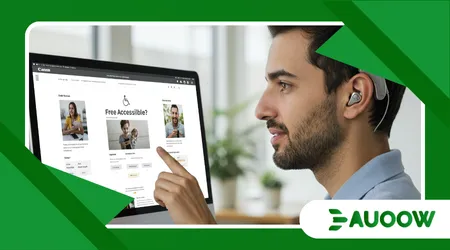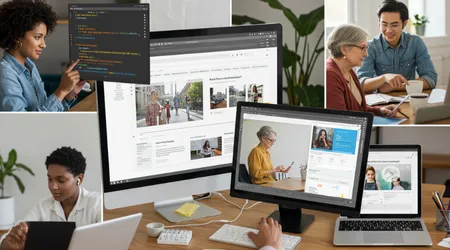Is Your Website Accessible? Free Tools That Actually Work

Is Your Website Accessible? In 2025, this question isn’t just ethical it’s a business imperative. Digital accessibility ensures websites are usable for everyone, including those with disabilities, while boosting SEO, user engagement, and brand loyalty.
With 20% of the global population relying on assistive technologies, neglecting accessibility alienates millions and risks legal repercussions.
This article explores why accessibility matters, offers practical free tools to test and improve your site, and provides actionable strategies to align with 2025’s Web Content Accessibility Guidelines (WCAG) 2.2. Let’s dive into creating inclusive digital spaces that work for all.
Accessibility isn’t a buzzword; it’s a commitment to inclusivity. Imagine a library where books are only on high shelves unreachable for many.
That’s an inaccessible website. By prioritizing accessibility, you enhance user experience, improve search engine rankings, and future-proof your site against evolving standards. Let’s unpack how to make your website a welcoming space for everyone.
Why Website Accessibility Matters in 2025
The digital landscape is evolving, and accessibility is at its core. Is Your Website Accessible? If not, you’re excluding 1.3 billion people with disabilities globally, per the World Health Organization.
Accessible sites are navigable by screen readers, keyboards, and other assistive tools, ensuring equal access. Beyond ethics, accessibility drives business success by expanding your audience and enhancing user trust.
Search engines like Google prioritize user-friendly sites. Semantic HTML, alt text, and clear navigation key accessibility features improve crawlability and SEO rankings.
++ Reviewing the Top 5 Screen Readers of 2025: Speed, Accuracy and UX
Accessible sites also reduce bounce rates, as users stay longer on intuitive platforms. In 2025, ignoring accessibility risks lawsuits, especially under laws like the ADA or European Accessibility Act.
Neglecting accessibility isn’t just a missed opportunity; it’s a liability. Businesses face reputational damage and legal penalties for non-compliance.
Prioritizing accessibility signals inclusivity, fostering loyalty among diverse users. It’s a win-win: better user experience and stronger market reach.

Free Tools to Test Website Accessibility
Testing accessibility doesn’t require a big budget. Is Your Website Accessible? Free tools can pinpoint issues and guide fixes.
WAVE, developed by WebAIM, scans pages for WCAG compliance, highlighting missing alt text or poor contrast. It’s user-friendly and offers detailed remediation tips.
Accessibility Insights, backed by Microsoft, checks for keyboard navigation and screen reader compatibility.
It’s ideal for developers tackling dynamic content. NVDA, a free screen reader, lets you experience your site as visually impaired users do, revealing navigation flaws. These tools are practical starting points for accessibility audits.
Also read: How Augmented Reality Assists Users with Spatial Orientation
Another gem is axe DevTools by Deque Systems. This browser extension identifies issues like improper headings and provides actionable fixes.
Regular testing with these tools ensures your site stays compliant and user-friendly, aligning with 2025’s accessibility standards.
| Tool | Purpose | Key Feature | Link |
|---|---|---|---|
| WAVE | Scans for WCAG compliance | Highlights missing alt text | webaim.org/resources/wave |
| Accessibility Insights | Tests keyboard and screen reader issues | Suggests fixes for dynamic content | accessibilityinsights.io |
| NVDA | Screen reader testing | Simulates user experience | nvaccess.org |
| axe DevTools | Identifies heading, contrast issues | Browser extension for quick scans | deque.com/axe/devtools |
Practical Steps to Improve Accessibility
Making your site accessible starts with small, impactful changes. Is Your Website Accessible? Use semantic HTML H1 for titles, H2 for subheadings to guide screen readers.
Descriptive alt text for images, like “A red apple on a wooden table,” aids visually impaired users and boosts image SEO.
Ensure keyboard navigability. Can users tab through all interactive elements? Test with NVDA to confirm. Clear navigation labels, like “Shop Now” instead of “Click Here,” help both users and search engines. Consistent layouts reduce confusion for cognitive disability users.
Read more: How Blockchain Could Help with Assistive Device Distribution
Optimize for mobile and low-bandwidth users. Compress images and minimize JavaScript to improve load times, enhancing Core Web Vitals scores.
ARIA attributes, like aria-label, clarify dynamic content for assistive tools. Regular audits with WAVE keep your site compliant and user-focused.
Current Trends in Accessibility for 2025
Accessibility is dynamic, shaped by technology and user needs. Is Your Website Accessible? In 2025, AI-driven tools like BrowserStack’s Accessibility Testing analyze real user experiences across 3,500+ browsers, catching edge-case issues.
Voice navigation is rising, with 40% of searches expected to be voice-based, per Statista.
WCAG 2.2 emphasizes cognitive accessibility, like clear language and predictable layouts. Businesses adopting these standards see a 50% organic traffic increase, as accessibility aligns with SEO best practices.
Inclusive design, like adjustable font sizes, caters to aging populations and temporary impairments.
Emerging technologies, like ARIA for interactive elements, enhance user experiences.
For example, a retail site using ARIA to describe a product slider ensures screen readers interpret it correctly. Staying ahead of these trends future-proofs your site and broadens its reach.
Common Accessibility Pitfalls and How to Avoid Them

Even well-intentioned sites fall short. Is Your Website Accessible? A common mistake is skipping heading levels, like jumping from H1 to H3, confusing screen readers. Always maintain a logical hierarchy H1, H2, then H3 for clarity and SEO benefits.
Another pitfall is vague link text, like “Learn More.” Instead, use “Explore 2025 Accessibility Guidelines” for context.
Low color contrast, such as light gray text on white, hinders readability. Use tools like WAVE to ensure a 4.5:1 contrast ratio for text.
Auto-playing videos without pause options frustrate users with sensory sensitivities. Always include controls.
Testing only with automated tools misses nuanced issues manual testing with NVDA or real users catches what algorithms don’t. Prioritize these fixes for a seamless experience.
Building a Culture of Accessibility
Accessibility isn’t a one-off task; it’s a mindset. Why settle for a site that excludes millions? Is Your Website Accessible?
Train your team on WCAG guidelines to embed inclusivity in every project. Involve users with disabilities in testing for authentic feedback.
For example, a Canadian news site revamped its navigation after user feedback revealed screen reader issues, boosting engagement by 30%.
Collaborate with accessibility experts to stay compliant. Regular audits and user testing ensure your site evolves with technology and user expectations.
Leadership buy-in is crucial. Frame accessibility as a growth strategy expanding reach and enhancing SEO rather than a compliance chore.
Tools like axe DevTools simplify ongoing monitoring, making inclusivity a seamless part of your workflow. Commit to accessibility as a core value.
FAQ: Addressing Common Questions
What is website accessibility?
It’s designing sites so everyone, including those with disabilities, can navigate and interact effectively, using tools like screen readers or keyboards.
Why is accessibility important for SEO?
Accessible sites improve user experience, reduce bounce rates, and enhance crawlability, aligning with search engine priorities like Core Web Vitals.
Are free tools enough to ensure compliance?
Free tools like WAVE and NVDA are great starting points, but manual testing and expert audits ensure full WCAG and ADA compliance.
How often should I test my site?
Audit quarterly with tools like Accessibility Insights and annually with user testing to catch issues and align with evolving standards.
